Peer-to-peer marketplace guide: How to launch, grow, and scale successfully
Peer-to-peer marketplaces have tremendous business potential—and building one is easier than ever. Here’s a practical guide based on 10+ years of experience working with successful marketplaces.
Peer-to-peer marketplaces are exploding in popularity. In 2023, the global sharing economy was valued at $287 billion and is projected to grow to a staggering $1.4 trillion by 2030. This includes the peer-to-peer marketplace sector, which is expected to grow from $1.5 billion in 2024 to $6.27 billion in 2032.
It’s easy to see why peer-to-peer (P2P) marketplaces have such huge potential.
For consumers, these platforms are an affordable, convenient, and environmentally friendly alternative to traditional consumption.
For aspiring entrepreneurs, marketplace businesses are an attractive business model that makes it possible to start scalable, game-changing businesses with limited resources.
At Sharetribe, we’ve worked with successful P2P marketplaces for over a decade (check out our customer gallery for some inspiring examples!). This practical guide is based on the lessons we’ve learned along the way. We hope it helps you turn your idea into a thriving peer-to-peer marketplace.
A peer-to-peer (P2P) marketplace is a website that connects people who own a product or offer a service with people who want to buy or rent it. Airbnb is a classic example.
In P2P, the role of the website (like Airbnb) is to help buyers and sellers find each other and make transactions safely and easily. The marketplace doesn’t need to own or provide any of the products or services offered on its platforms.
In addition to Airbnb, famous examples include the product-selling website Etsy and the ridesharing app Uber. Almost any product or service can be sold through a P2P platform. Sharetribe customers have built marketplace sites for everything from selling pre-loved children’s stuff to private swimming pool rentals.
Plus, the second-hand economy is booming, with big brands like Lego, Shein, Zara, and Ikea entering a market traditionally dominated by thrift stores and small resellers. Fashion resale platforms, in particular, are flourishing—ThredUp was valued at $1.3 billion in its IPO in 2021 and has partnered with major retailers like Gap.
Let’s look at three peer-to-peer marketplace types and examples more closely: peer-to-peer rentals, products, and services.
Peer-to-peer rental marketplaces let consumers rent items from other consumers. Famous examples include Airbnb, Turo, and Vrbo. These platforms help consumers find each other, trust one another, and make secure payments.
Opportunities for these kinds of marketplaces are everywhere. For example, Sharetribe customers have built sites for swimming pools, cars, sporting equipment, and much more.
You can find inspiration for peer-to-peer rental marketplaces in our Customer Gallery, where you can browse marketplaces by type and sales model.
Etsy is an example of a tremendously successful peer-to-peer product marketplace. On Etsy, anyone can sell handmade items to other consumers—the marketplace helps connect buyers and sellers and facilitates their transactions.
Secondhand sites like Poshmark and Vinted are another common example. And as marketplace technology becomes more accessible, many marketplace founders have started thriving businesses by focusing on serving a clearly defined niche. For example, our customer, The Octopus Club, is a thriving community of like-minded parents buying and selling second-hand children’s clothes and items. Lumikha is a fast-growing marketplace by cosplayers, for cosplayers.
Our customer gallery has a whole slew of inspiring peer-to-peer product marketplace examples.
Peer-to-peer service marketplaces connect consumers who want to buy services from other consumers. Uber and Lyft are famous examples, but the opportunities are endless!
How about a marketplace to find a local tour guide for your next vacation? A website where home cooks can sell the extra food they make in their neighborhood? A platform where hobbyists can offer live online classes in their specific skills?
Check out some more P2P service marketplace examples in our Customer Gallery.
As you can see, almost any niche and industry can be fertile ground for a thriving peer-to-peer marketplace. In addition, the marketplace model can bring significant benefits to a business. The next section discusses those and some key challenges founders need to solve.
Sometimes, peer-to-peer marketplaces are referred to as customer-to-customer (C2C) marketplaces.
In practice, these terms are the same. Both refer to situations where private individuals exchange value with one another.
The term C2C belongs to the same group of terms as B2B (business-to-business) and B2C (business-to-consumer). Sometimes, P2P has been used to highlight that a marketplace is only about sharing and no money exchanges hands, whereas C2C is seen as a more traditional value exchange between private consumers.
However, this distinction isn’t necessarily meaningful because many P2P marketplaces enable both free sharing of goods and services and charging for them. In most contexts, C2C and P2P are used synonymously.
There are many reasons why a peer-to-peer marketplace can be a tremendously successful business. Let's look more closely at its key benefits.
One of the primary advantages of marketplaces is that setting up one is relatively fast and inexpensive.
In most industries, investing in inventory is the biggest startup expense. But marketplace businesses don’t have to pay for inventory—suppliers create it for them.
Consider a marketplace like Airbnb. The top five hotel chains in the world have about 4 million rooms combined. Meanwhile, Airbnb has over 7.7 million listings worldwide—all without owning a single hotel.
How is this possible? Instead of buying real estate, Airbnb operates a peer-to-peer rental model: its platform has millions of listings, enthusiastically provided by hosts worldwide.
P2P marketplaces focusing on products or services are similar. Building a website like Etsy doesn’t require manufacturing products. Uber doesn’t own cars.
Not investing a five-figure sum in platform technology or inventory makes it much easier to start a business. Instead, founders can spend their budget on growing their marketplace.
One of the biggest advantages of the peer-to-peer marketplace model is its ability to scale without the traditional barriers of inventory or linear operational growth.
In a P2P marketplace, supply and demand grow together, and the platform acts as the facilitator, not the owner, of goods or services. As your user base grows, your marketplace becomes more valuable—you almost never need to expand warehouses, hire more service providers, or purchase new assets.
With the right systems, such as built-in payment processing, trust mechanisms, and user management tools, you can scale sustainably and efficiently. Marketplace software builders like Sharetribe are designed to support this flexible, compounding growth from day one.
Peer-to-peer marketplaces offer a variety of ways to earn revenue, so you get the flexibility to tailor your business model to your niche and users’ needs. The most common approach is charging a commission fee for each transaction, which is ideal for platforms that want to align revenue growth directly with user activity.
Subscription models, where providers pay a recurring fee to access the platform or premium features, can create more predictable income once you’ve validated supply and demand. Listing fees offer a simple way to monetize without taking a cut of transactions, while value-added services like insurance, verification, or promoted listings unlock additional revenue streams.
As your marketplace matures, you can combine multiple models to optimize both growth and profitability. For example, Etsy uses the following revenue streams:
- Commission fees: 6.5% transaction fee on each sale
- Listing fees: $0.20 fee for sellers to list an item for four months
- Value-added services: Paid advertising options and payment processing
Peer-to-peer marketplaces get to enjoy powerful built-in network effects. If each new user (buyer or seller) increases the overall value of the platform, then the business has network effects.
Businesses with network effects often scale much quicker than those without. More customers mean more demand, which brings in more suppliers. More suppliers mean more selection, which creates a better customer experience and brings in more customers.
If done right, this creates a flywheel effect, where the marketplace grows exponentially through the power of network effects.

For a long time, the primary barrier to developing a peer-to-peer marketplace was the complexity of building a site that could handle both buyers and sellers. Development was costly and time-consuming, and the process required a team of highly skilled developers. Platforms focusing on peer-to-peer rentals or services were a particular challenge.
But marketplace technology has advanced rapidly. You no longer need to code a platform from scratch. At Sharetribe, for example, we help entrepreneurs launch their peer-to-peer marketplaces faster. Sharetribe is ideal for founders who want to launch fast without coding. It lets you quickly launch a no-code marketplace and extend your platform by developing a unique marketplace on top of our APIs.
In addition to using dedicated software, many alternatives fit all skill levels and budgets. If you decide to use marketplace software, we also have articles that help you compare Sharetribe alternatives.
There are a few common challenges that you might face in your entrepreneurial journey. Here are the biggest challenges and our recommendations for solving them.
Before making significant time and financial commitments, you must validate your idea first. Focus on launching the first version of your marketplace as soon as possible. Get feedback from early users to develop your marketplace further.
Another common challenge is finding the right niche. At first, it makes sense to focus on a small niche and vertical. While it’s great to dream big, a lack of focus can hamper your business, especially in the early days. Focus on finding product-market fit, then scale to other markets and categories.
There are several different marketplace business models. To find one that’s sustainable and scalable, start by understanding how value flows through your platform. Ask yourself, who benefits the most, and where does money change hands?
Then test pricing with early users and make sure it works for your sellers, buyers, and business needs. As you grow, revisit your model to ensure it still aligns with user behavior and platform goals.

At first, the idea of sleeping in a stranger’s apartment seemed terrifying. But now, millions of people stay in Airbnbs across the globe every night.
As consumers, we implicitly trust the brands we know. As a new business, you won’t have that level of brand strength; trust is built over time. Fortunately, there are many proven strategies for building marketplace trust.
As you develop your peer-to-peer business, watch out for these challenges. But be confident in your ability to deal with them. There are things you can do to mitigate the risks when you build your business with an iterative mindset. Understanding the essentials you need—and building upon them step by step—helps you create a profitable business without taking on too much risk.
Legal compliance isn’t the most exciting part of building a marketplace, but overlooking it can create serious risks later on.
Peer-to-peer marketplaces must navigate regulations around:
- Payments
- Taxes
- User data protection (like GDPR or CCPA)
- Regional business laws
These requirements vary widely depending on your target audience and operating regions, which makes compliance a little tricky.
To be prepared from the start, consult legal experts, choose a marketplace solution and a payment provider that will take care of a lot of your regulatory obligations, and set clear terms of service. These precautions will help protect your marketplace as it grows. Take compliance seriously at the beginning to build the foundation for long-term success and trust.
In P2P marketplaces, the platform doesn’t control the product or service quality—the users do. This makes maintaining a great user experience more challenging, but also more critical.
Strong trust systems are essential, so build in user ratings and reviews, offer identity verification options, and provide responsive support when problems arise. Clear community guidelines and proactive moderation can also help set expectations early. When users trust that your marketplace consistently delivers quality, they’re more likely to return and recommend it to others, which will fuel your platform’s long-term growth.
P2P sites demand a distinct set of features compared to other e-commerce businesses. That's why generic online store builders like Shopify, Magento, or WooCommerce rarely work for marketplaces. And developing a peer-to-peer marketplace from scratch can set you back several months and tens of thousands of dollars.
The good news is that the essential marketplace website features form a solid foundation for your business, whether your idea is about peer-to-peer rentals, products, or services. That's why dedicated marketplace builders can offer an affordable way to get started.
Here are the features that the majority of peer-to-peer platforms need from day one:
- User profiles
- Listing pages and listing creation
- Website navigation and search
- Online payments
- Reviews
- Messaging and notifications
- Admin features
Let's look at each of these features and functionalities a bit more closely. You'll find an image of how each one looks in Sharetribe's no-code marketplace builder.
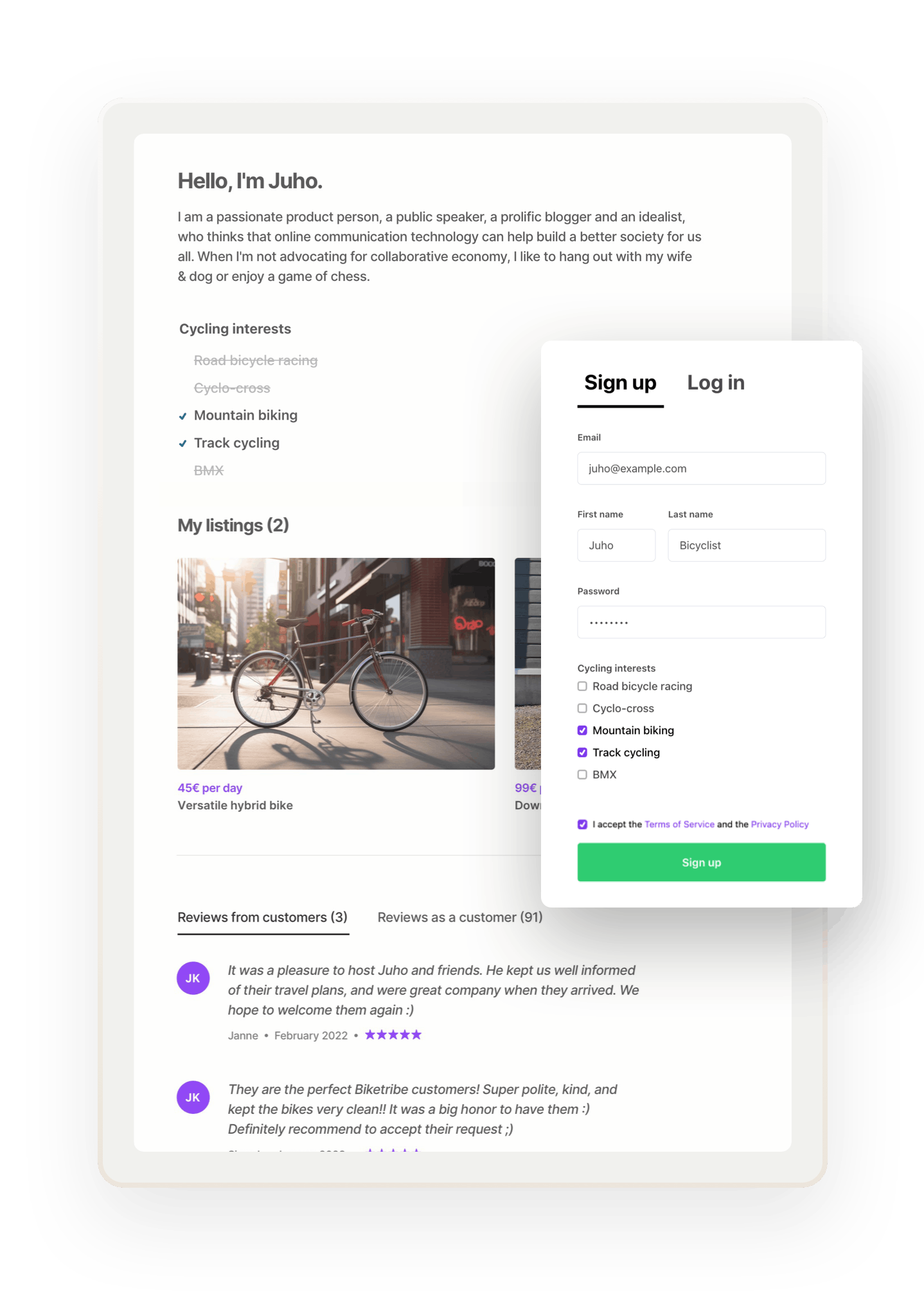
User profiles
Profiles are an essential component in building trust between customers and providers. Users will share information about themselves on their profile: their name, picture, and location. Some platforms might verify phone numbers and identities, but these typically aren’t shared with other users.

Listing pages and listing creation
A listing page allows sellers or suppliers to showcase what they’re offering and commonly includes a text description, pictures, videos, pricing, and reviews. The more complete and professional a seller’s listing page is, the better they will typically perform on the platform.
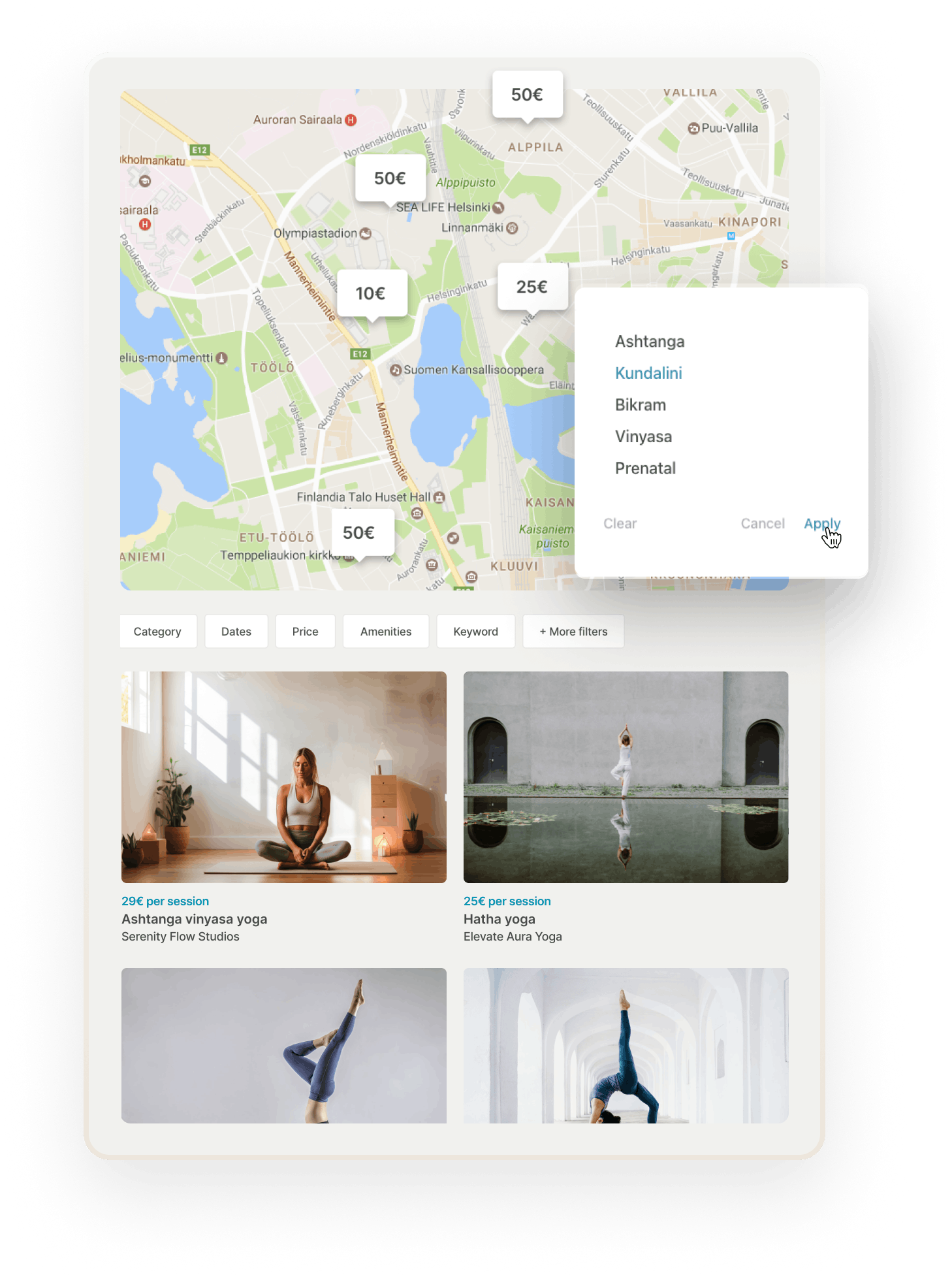
Website navigation and search
Keyword searches work well for marketplaces dealing with shippable products or online services. Marketplaces like Airbnb will also need a location search and the ability to display listings on a map.
Alternatively, customers can navigate by categories that you define. You’ll need to determine how to categorize your listings best; most sites have a hierarchical structure, with main categories and subcategories.

Online payments
Smooth and secure marketplace payments are a core value proposition for peer-to-peer marketplaces like Airbnb, Etsy, and Uber. Processing payments is also critical to their business model because they monetize through commission. Fortunately, there are hundreds of payment providers that can be integrated into your marketplace platform.
Sharetribe comes with a pre-built integration with Stripe Connect, but you can also build a custom integration with any third-party payment provider you choose.
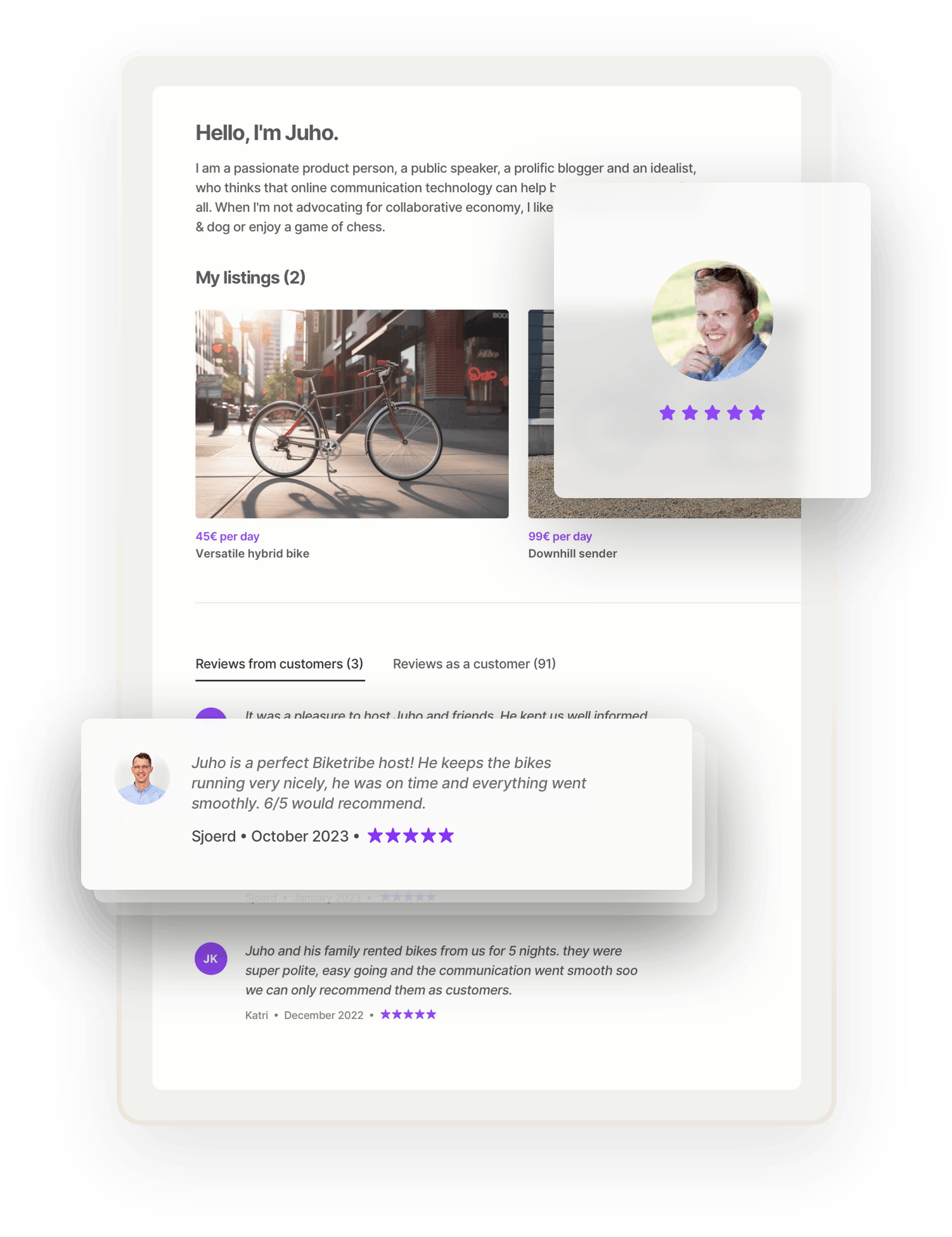
Reviews
Reviews are essential for building trust between users, especially on a P2P marketplace. They give customers confidence in the product or service, and offer providers assurances that the sellers will treat their belongings well. After the transaction is completed, reach out to both groups to ask for a review.

Messaging and notifications
Your customers and providers need to communicate. A messaging service that supports multiple conversations can achieve this. The communication platform should also send notifications about new requests, transactions, and reviews.
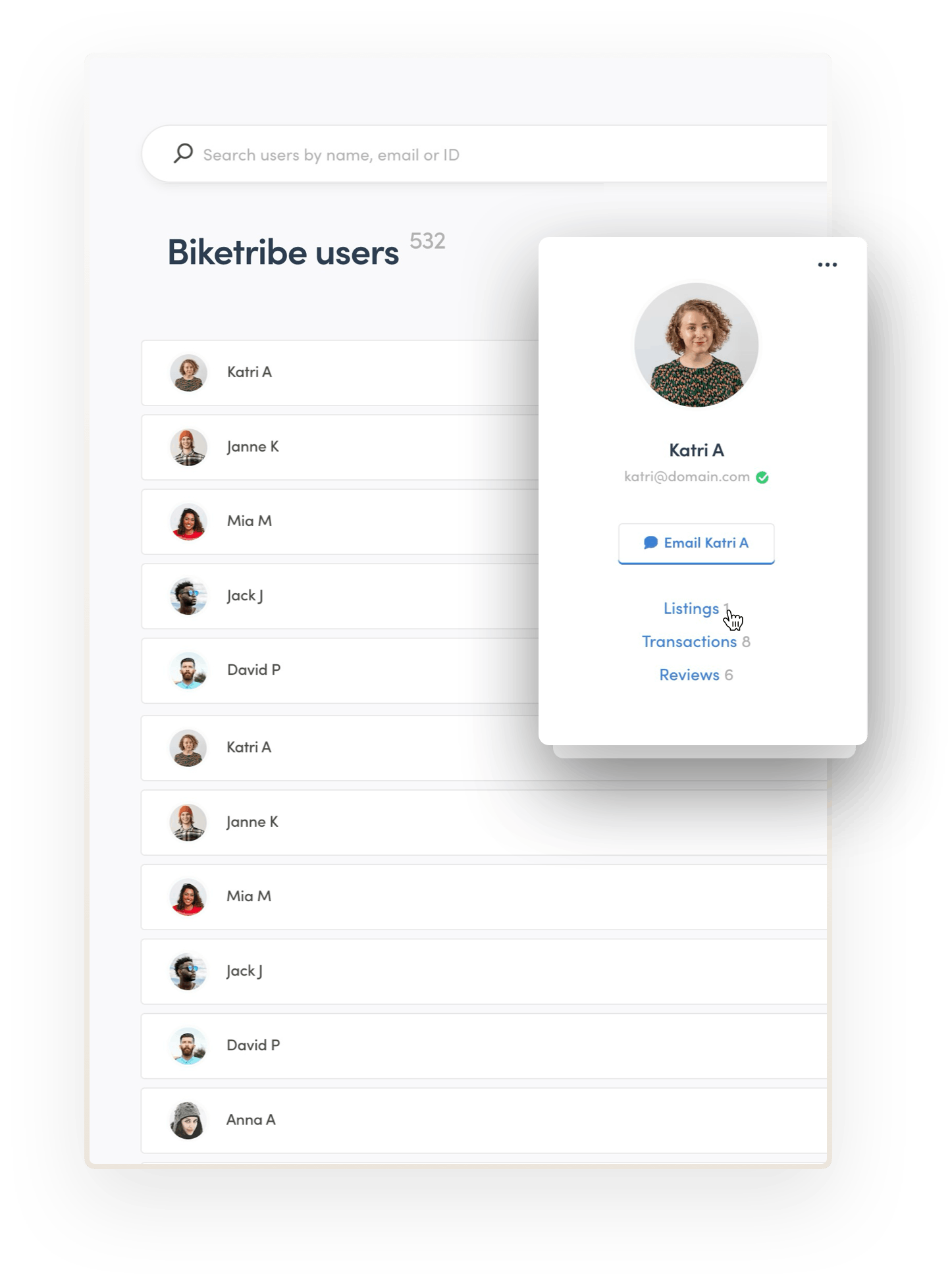
Admin features
Behind every thriving peer-to-peer marketplace is daily monitoring and management. As a marketplace admin, you’ll want to be able to moderate user-generated content like profiles and listings, control user access, see your transaction processes, send notifications, and so on.
Powerful admin tools let you ensure your marketplace’s user experience works smoothly. They also let you track user behavior and develop ways to improve your platform. In Sharetribe, building and managing your marketplace happens through Sharetribe Console.
In addition to the essentials listed above, there are other features you might want to consider, depending on the needs of your users:
- Booking calendars and availability management if you’re dealing with peer-to-peer rentals or services.
- Integrated maps if your marketplace is location-based and your users need to meet face-to-face.
- Shipping might be required if your marketplace deals with peer-to-peer product selling.
- Identity verification protocols are useful for trust-intensive markets, like peer-to-peer apartment rentals, babysitting, or the like.
Sharetribe supports all of the marketplace essentials out of the box, and you can easily expand the offering with third-party integrations or through custom development.
Building a successful peer-to-marketplace business doesn’t have to be a months-long, expensive project.
Instead, treat it as a process of learning and iteration.
Great businesses take time to build. In a nutshell, there are a few main steps to getting your marketplace up and running:
- Find and validate a great peer-to-peer marketplace idea
- Find the right business model
- Start small and grow your niche
- Build your Minimum Viable Product (MVP)
- Launch early and learn from your audience
We’ll cover them briefly here, but for a more detailed breakdown of each step, check out our complete guide to how to create a marketplace.
All great businesses start with a great idea.
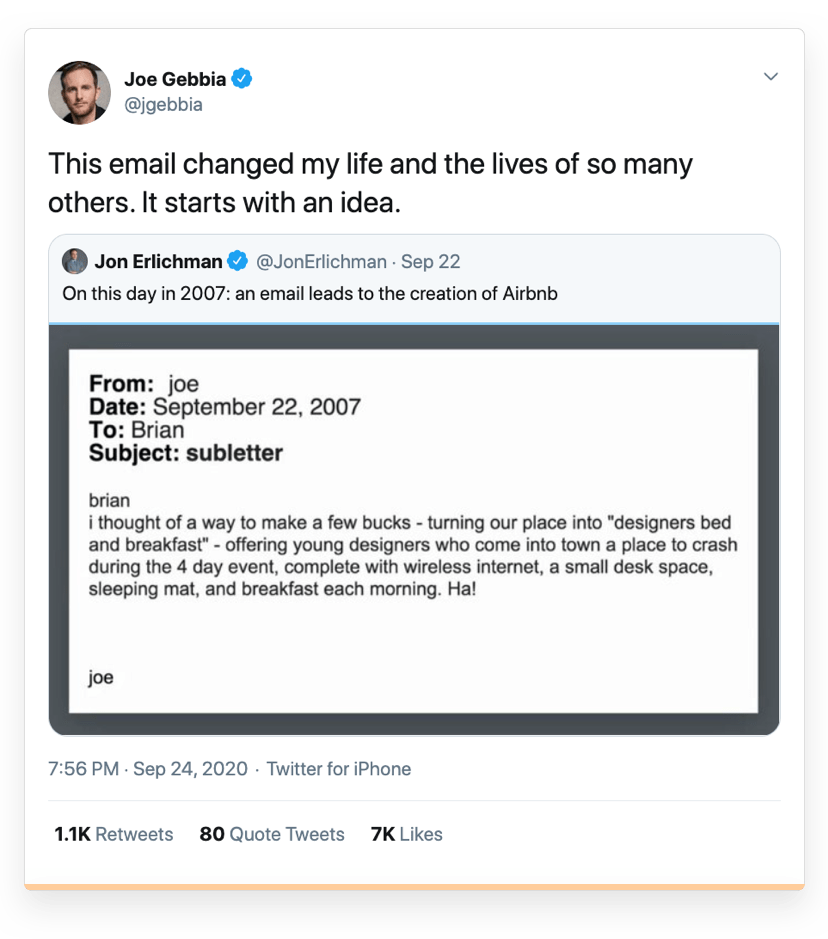
But at first, it can be difficult to tell whether your idea is worth pursuing. You might think it’s great, and the potential users you interview might also think so. Who wouldn’t want to see more peer-to-peer rentals and second-hand purchases in the world?
But what really matters is whether people will like it enough to pay to use it.
At their core, successful businesses solve problems for their customers. Founders often start companies in response to their own problems. The idea for Airbnb came when the founders were having trouble making rent.
Marketplaces have an extra layer of complexity: you need to solve problems for two groups—prospective buyers and prospective sellers. A great idea must attract enough supply and enough demand to function.
For example, for a peer-to-peer rental business, you need to identify an asset that:
- Many people own
- Is underused or idle much of the time
- Could be rented instead of bought
A great example is expensive items to buy and/or maintain. People who already own them are likely willing to cover some of the costs by renting rather than letting the asset sit idle. And customers may want to rent the asset when they need it rather than make an expensive investment in owning it.
Once your idea passes this test, validate it with potential users. Talk to them and challenge your assumptions. But ultimately, you won’t truly know if you’re solving a real problem until you launch your marketplace business.
Our advice is to launch fast and launch cheap. The most valuable insights come from live users paying to use your service.
As an inspiring example of this approach, check out the story of Raphaëlle de Monteynard, founder of Swimmy. She had an idea for a peer-to-peer rental marketplace that lets people share private swimming pools. To get started, she did extensive research on the market. Soon, she realized the best thing she could do was to launch her business quickly for the summer season and see how it went.
“Everything doesn’t have to be perfect when you start a business. The most important thing is to learn if your idea will work, and you don’t need a lot for that,” she says.
Today, Swimmy has over 45,000 users.
Failing to validate a business idea is a common mistake for founders. It’s all too easy to get excited and throw yourself into building a platform. But before you do that, make sure people are actually interested in using your platform.
If your idea fails, it’ll fail fast. You’ll have time to pivot to a new idea, and you won’t have wasted months and thousands of dollars developing a complex website that nobody wants to use. But if you see signs of initial traction, it’s go time.
As you build your marketplace, consider your business model. At first, it might make sense to keep costs low to attract more users. But ultimately, the revenue model must finance the business’s operations.
The majority of peer-to-peer marketplaces use commission-based models.
With this model, the business takes a commission on every transaction made on the platform, either as a percentage cut or as a fixed fee. A significant benefit of the model is that it works regardless of marketplace type, whether your idea is to sell services, products, or peer-to-peer rentals. The most successful marketplaces—Airbnb, Etsy, Uber—all built their businesses on a commission structure.
Check out this guide for information on other marketplace business models.
Pros
- Low barrier to entry for providers: Sellers aren’t charged upfront, so they only pay when they successfully make a sale. This makes attracting and onboarding initial supply easier, which is critical for early marketplace traction.
- Revenue aligns with platform growth: As more transactions occur, revenue increases automatically without needing a major pricing overhaul. The model naturally scales alongside your user base.
- Built-in incentive alignment: Providers are motivated to succeed because their fees are tied to their sales, and the marketplace is motivated to help sellers succeed to earn commissions.
- Flexible for different business stages: You can start with a simple flat commission and introduce tiered or variable commissions later as your marketplace matures and diversifies.
Cons
- Risk of platform leakage: If your marketplace doesn’t deliver enough value relative to the commission fee, users may complete transactions off-platform, causing you to lose revenue. Strong value propositions and trust-building features help prevent marketplace leakage.
- Complex payment infrastructure: It would be very difficult to build a payment infrastructure from scratch that accurately applies commissions to every transaction while staying compliant with global payment regulations. Marketplace builders with pre-built, compliant payment integrations (like Sharetribe, which comes with a built-in integration to Stripe Connect) can simplify this process.
While commission-based models are the most common, many successful marketplaces combine multiple monetization strategies as they grow. You can learn more about how successful marketplaces monetize in our in-depth study.
Here are a few other business model options to consider:
Subscription fees
Subscription models charge users (usually sellers) a recurring monthly or annual fee to access the platform or unlock premium features. They provide predictable, recurring revenue and can help filter for higher-quality, more committed suppliers.
However, they may create a barrier to entry for new users, so they work best once you’ve validated demand or as part of a tiered (freemium-to-paid) approach.
Premium listings
Premium listings allow users to pay to “boost” or feature their offerings for better visibility in search results or homepage placements. This option gives sellers a way to stand out in competitive categories while generating additional revenue without charging every user.
Premium placements work best when your marketplace already has enough inventory and traffic, and they should be implemented carefully to avoid harming the user experience. Often, premium listings are used as a supplementary revenue stream, in addition to commission or subscription fees.
Paid advertising
Paid advertising models offer display or native ad space on your platform, either to your own users (like sellers promoting products) or third-party advertisers. Ads scale well with traffic and provide another layer of monetization, especially for content-heavy or high-traffic marketplaces.
However, you should be thoughtful when introducing advertising. Overuse or poor targeting can dilute user trust and damage the platform’s brand.
Launching a successful marketplace starts by solving a very specific problem for a narrow group of users.
Focus on a vertical niche or a small geographic area to reduce complexity, concentrate supply and demand in one space, and build momentum faster. It also helps you overcome the chicken and egg problem, one of the biggest early challenges for marketplaces.
A small, focused launch lets you gather user feedback quickly, iterate on your offering, and grow sustainably. Sharetribe’s MVP approach is designed exactly for this: launch fast, learn fast, and scale from a strong foundation.
Here are some examples of successful peer-to-peer marketplaces that started in specific niches and grew:
- Drive Lah: Peer-to-peer car sharing in Singapore
- Swimmy: Private swimming pool rentals in France
- PaulCamper: Campervan rentals in Germany
- Curtsy: Second-hand fashion for young women
- Shortboxed: Marketplace for collectible comic books
A Minimum Viable Product, or MVP, is the earliest iteration of your platform that you share with customers. Even when you’re launching quickly, don’t rush—it’s vital to offer even your earliest users a great experience.
Before you launch an MVP, your marketplace should be functional. Users should be able to accomplish the basic goal of what your marketplace promises to do. The essential features outlined in the previous section form a solid foundation for your MVP. And depending on your marketplace type, you may need to set up secure payment processing and consider insurance options to protect your users.
There are many different approaches to marketplace development, but at this stage, focus on an approach that helps you build as fast as possible. Invest most of your time and initial budget in growing your audience, building your brand, and learning about your users.
If you’re looking to launch your MVP quickly, Sharetribe could be a great option. You can set up your peer-to-peer rental, product, or service marketplace in minutes, and all the essential features you need to get your business up and running come included.
You don’t need to code anything; technical details like hosting, maintenance, and updates are taken care of for you. You can use Sharetribe to launch your marketplace in less than a day and start learning from early users.
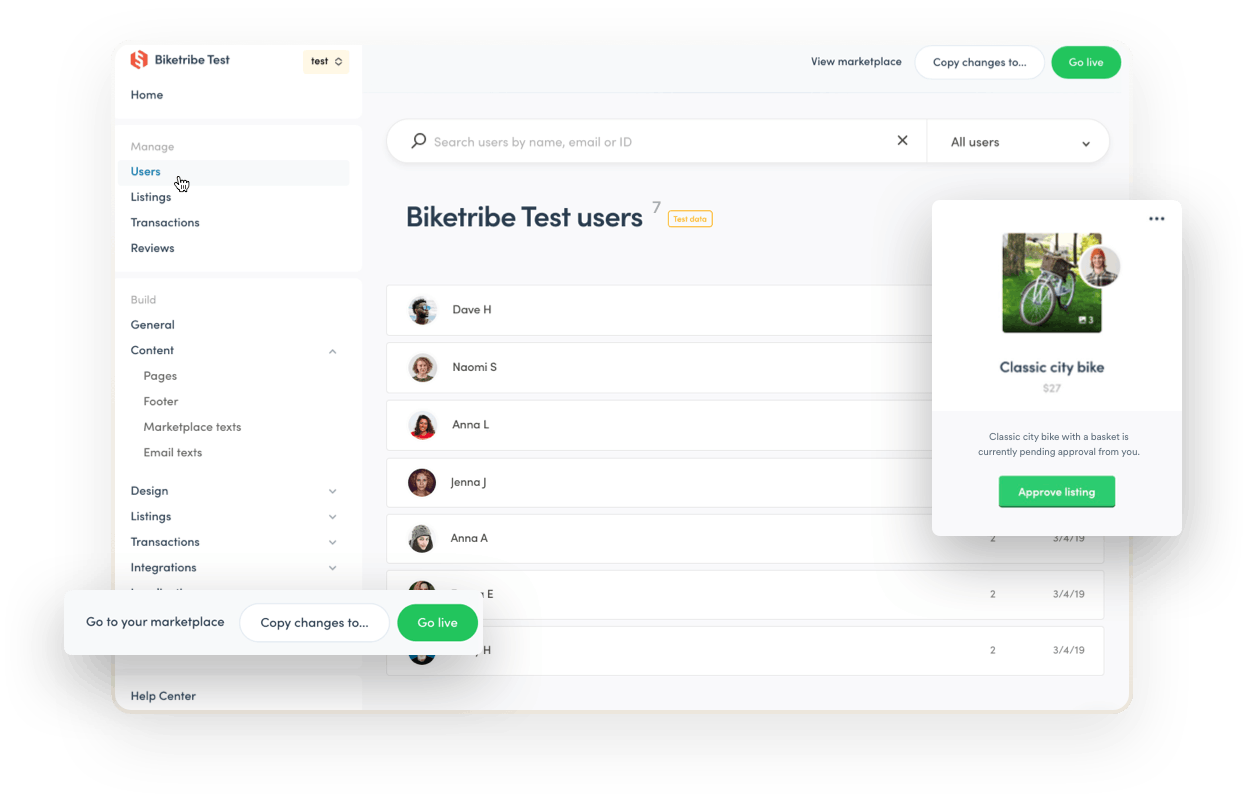
Once your MVP is ready, it’s time to launch.
While it’s tempting to jump in at the deep end, your launch should be a thoughtful process. Marketplaces are challenging businesses to build. You need to develop both supply and demand – no easy feat.
Begin by recruiting an initial group of providers to seed your marketplace with. Finding the right vendors can be challenging, and how you recruit them depends on the business you’re in. To start, contact providers on other marketplaces, search on Google, and reach out to forums and Facebook Groups.

At this stage, it’s fine to do things that don’t scale—the first hundred or so providers are the lifeblood of your platform. Make sure your new providers are comfortable using your platform, understand the benefits you offer, and see the potential in the marketplace.
As you approach your launch date, consider doing a product launch before your big marketing launch. This lets you onboard a small initial group of users on the platform to iron out any bugs before your big launch.
After launching, the real work begins. Give users your MVP, watch how they interact with it, identify bottlenecks, and collect feedback to improve. Some effective tactics include:
- Founder-led onboarding: Personally guide early users through your platform to learn where they struggle or need more support.
- Surveys: Regularly ask your users for feedback about their experience, features they want, and areas of friction.
- Analytics: Establish key marketplace metrics that offer genuine insight into the traction of your platform. Track user behavior to identify friction points and opportunities for improvement.
As you scale, conduct growth experiments to determine the optimal ways to build your business. Our guides on scaling your marketplace, double-blind reviews, and helping customers find the right product or service can guide your next steps.
Peer-to-peer marketplaces can grow slowly—it took Airbnb four years to see real traction. It’s critical to experiment with different growth channels and perfect your strategy for each one.
Don’t forget to learn from other founders who’ve been in your shoes. The Two-Sided podcast features in-depth interviews with successful marketplace entrepreneurs who share real-world lessons on how they launched, overcame early challenges, and grew their platforms sustainably. One example is focusing on just one city at a time to build traction before expanding further.
Once your marketplace grows, you have more resources to develop it further. You’ve also learned a lot about your audience and know what kinds of custom features and additional tools bring the biggest boost to user experience—and the biggest return on investment for you.
Sharetribe allows you to launch completely no-code and extend your design and feature set infinitely with code, all without changing platforms or migrating data. Our headless marketplace approach is ideal for entrepreneurs who want to take their businesses to the next level. Sharetribe offers all essential features and management tools off the shelf and allows marketplace owners to custom-develop a unique user interface on web or mobile on top of the Sharetribe-powered backend.
If you don’t have a developer on your team, Sharetribe’s Expert Network is here to help you find the right developer to build your platform. Check out our guide to finding a marketplace developer.
You can build custom features and add integrations to third-party tools like marketing and email software. Yet, you won’t have to invest in building the marketplace essentials; updates, maintenance, and security compliance are also handled for you.
We're proud to power over 1,000 marketplaces worldwide. Here are a few inspiring examples of peer-to-peer businesses. You can find more Sharetribe examples and inspiration in our customer gallery and founder stories.
Rental platforms allow people to rent out tangible physical resources that belong to others. Some of our favorites include:

Swimmy
Happiness is meant to be shared! Swimmy lets individuals find and rent private pools in France.

Drive lah
Drive lah is Singapore’s largest car-sharing community that allows customers to rent cars from locals and work towards a greener future.
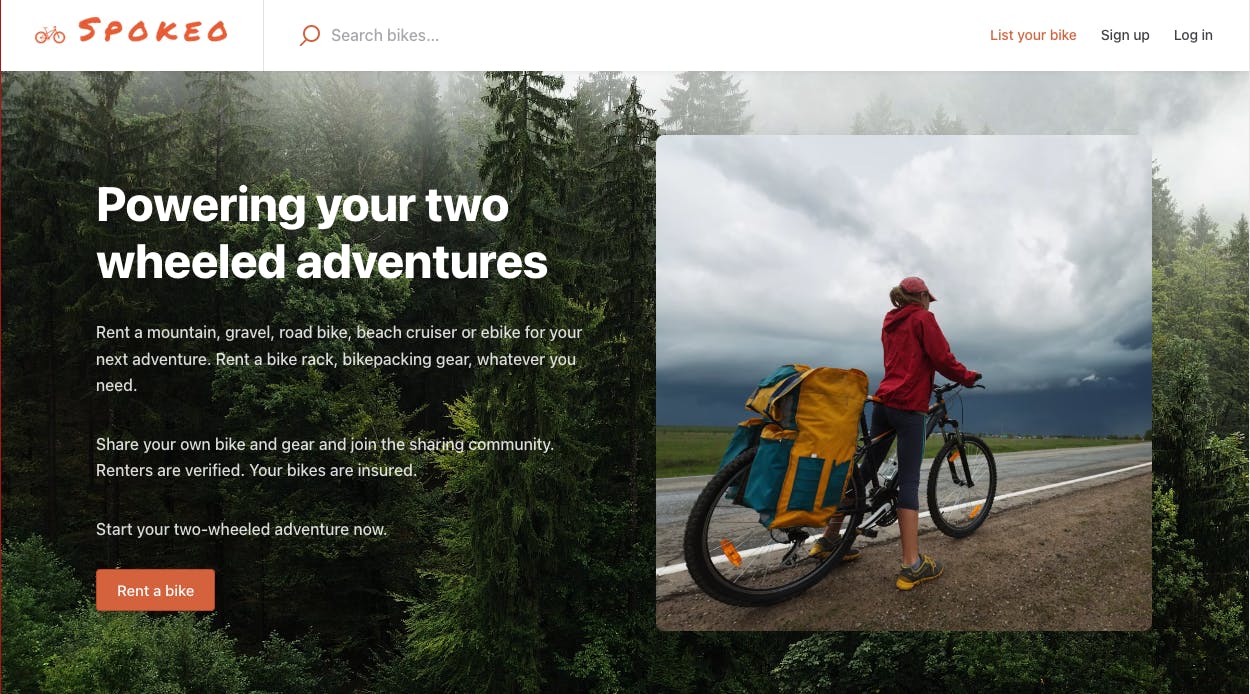
Spokeo
Spokeo is a Seattle-based bike-sharing platform that connects bike owners with individuals seeking to rent bicycles and cycling gear. It offers a range of options, including road bikes, mountain bikes, e-bikes, and bikepacking equipment.

The Octopus Club
The Octopus Club is a second-hand marketplace for parents who want to buy high-quality, gently used clothing and toys for their children.

Sugarlift
Sugarlift is a contemporary art gallery and online marketplace based in New York City that aims to make the art world more accessible by connecting collectors with today's leading contemporary artists. The platform features curated exhibitions, art consulting services, and a global artist community that allows buyers to discover and purchase artworks directly from artists.
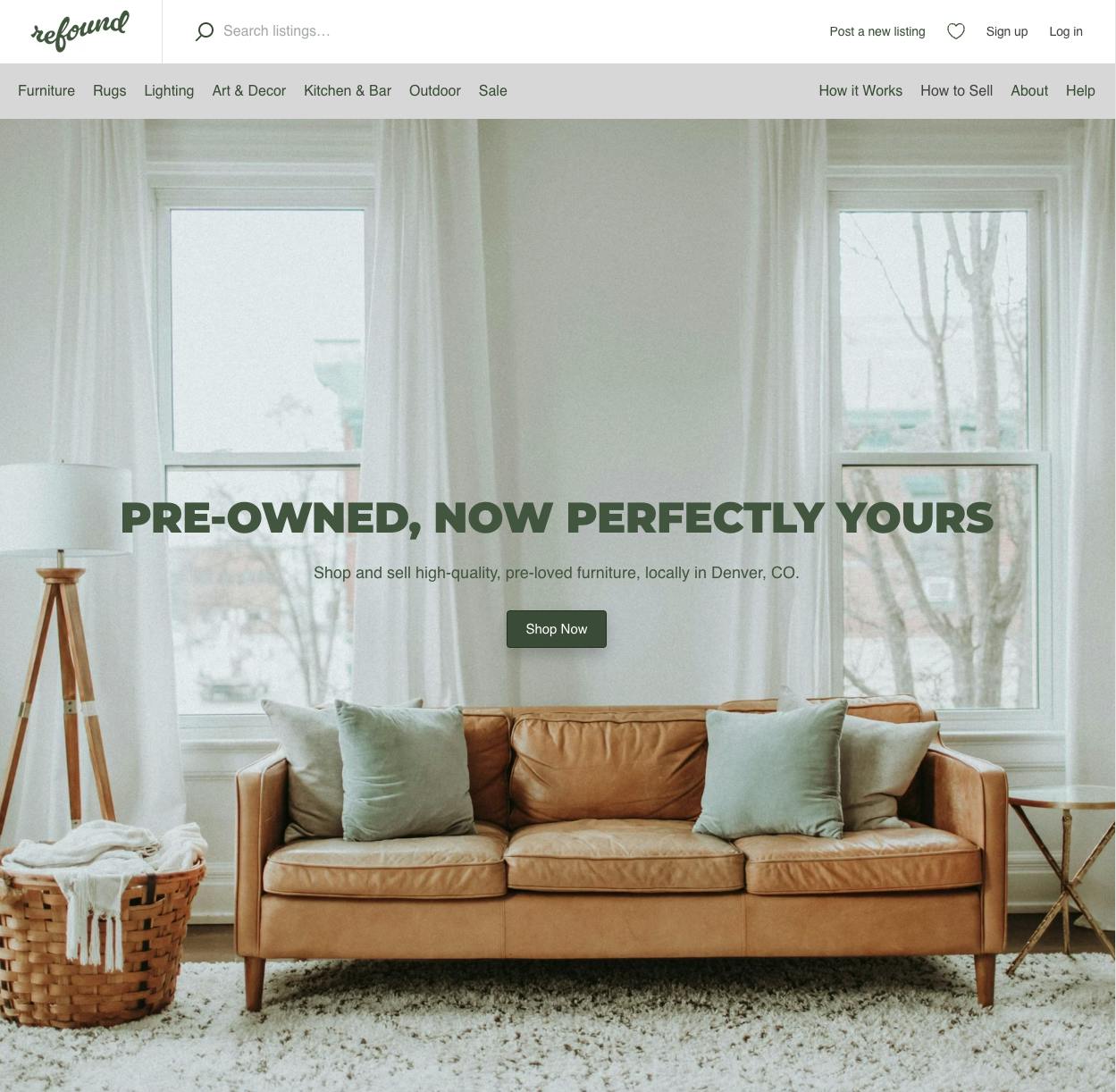
Refound
Refound is a Denver-based online marketplace specializing in vintage and pre-owned furniture and home goods. It offers a platform for people to buy and sell unique, second-hand items locally. Refound emphasizes a safe and secure transaction process, providing verified sellers, secure online payments, and local delivery options.
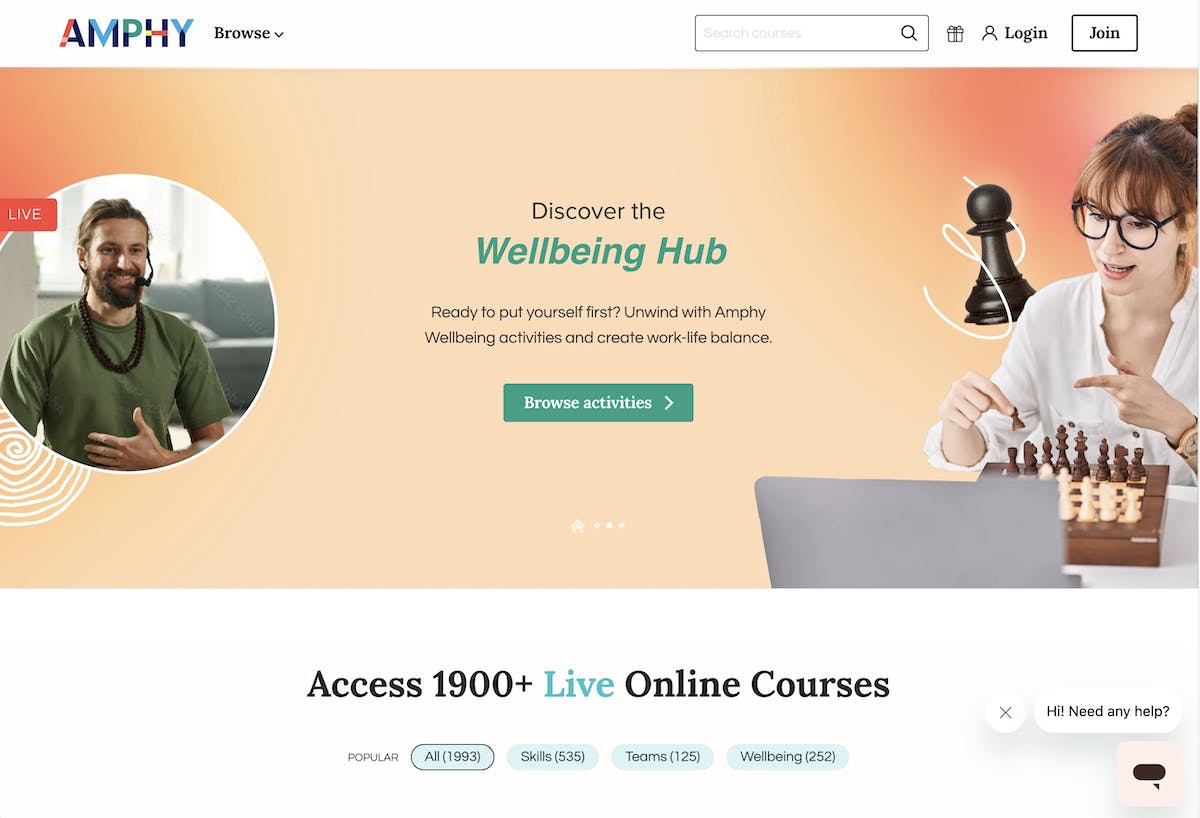
Amphy
Amphy is an online e-learning site that offers live educational courses, classes, and virtual tours.
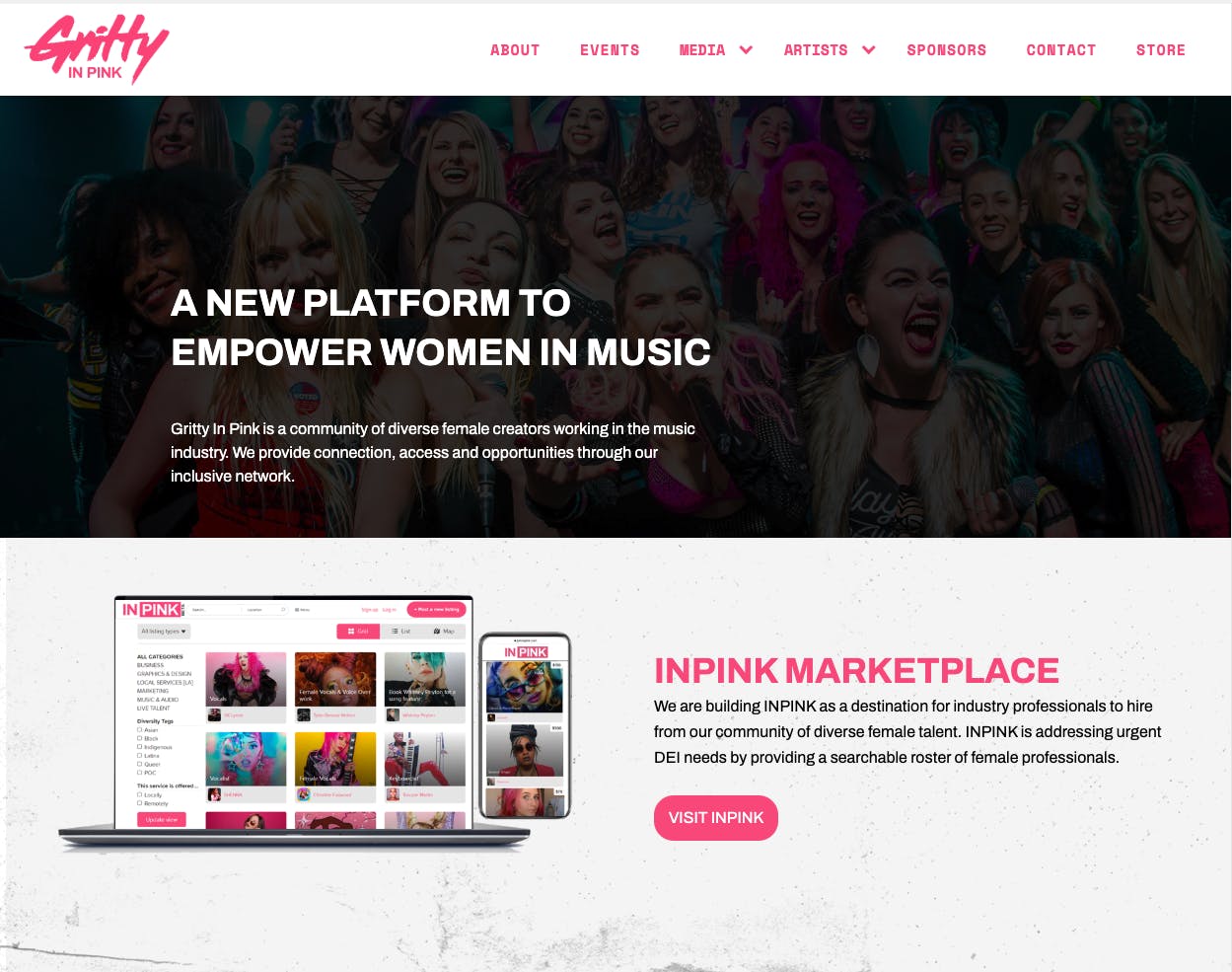
Gritty In Pink
Gritty In Pink is a platform dedicated to empowering women in the music industry by connecting female creators with industry professionals seeking diverse talent. Their online marketplace, INPINK, offers a searchable roster of women across various roles in music and entertainment to facilitate hiring and collaboration opportunities.
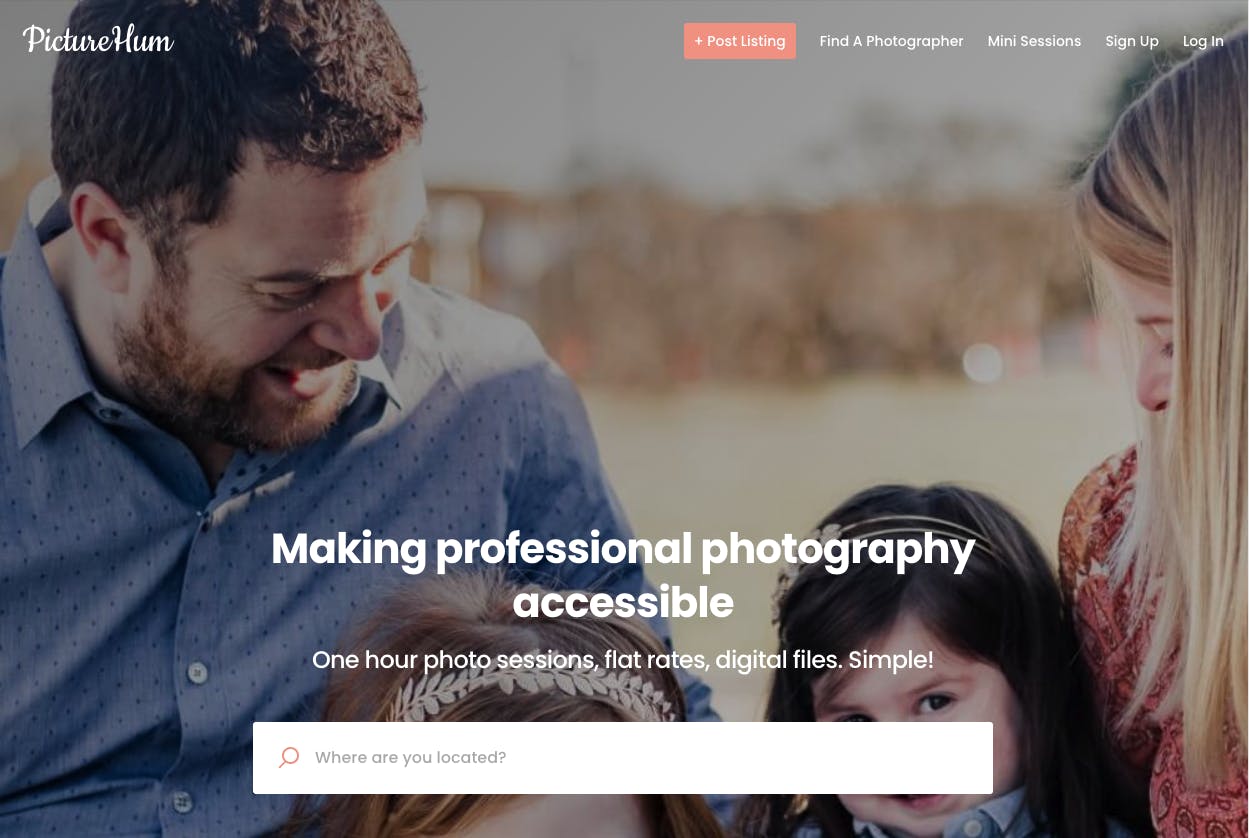
PictureHum
PictureHum is an online marketplace that connects families with professional photographers for one-hour photo sessions at flat rates. The platform simplifies the process of finding and booking local photographers with transparent pricing and quick delivery of digital images.
It’s never been easier to build a peer-to-peer marketplace business. There’s so much upside to the two-sided marketplace model, with unlimited potential for creativity and growth. With the right idea, marketplace builder, and a commitment to learning from your users, you can build something powerful and lasting.
You don’t need a big team or a massive upfront investment to create an online marketplace. With Sharetribe, you can launch quickly, validate your idea, and grow sustainably—all without writing a single line of code.
Sharetribe has everything you need to power your marketplace from day one: listings, profiles, bookings, payments, reviews, messaging, and admin tools. So you can focus on building supply and demand, learning from real transactions, and scaling at your own pace.
As you grow, you can customize your platform with code, connect external tools via APIs, or collaborate with one of our Expert developers. Whether you’re renting goods, selling products, or offering services, Sharetribe gives you the flexibility to adapt your marketplace as your vision evolves.
We’ve worked with peer-to-peer marketplaces for over a decade, and more than 1,000 marketplaces built on Sharetribe infrastructure are doing great things worldwide. If you’re interested in hearing more, our expert support team will be happy to help. Reach out to us at hello@sharetribe.com or visit our Help Center.
Get a free trial of Sharetribe and start building your peer-to-peer marketplace today.
Here are our answers to common questions about peer-to-peer marketplaces.
Peer-to-peer marketplaces typically make money by charging a commission fee on user transactions. Some also offer premium listings, subscription plans, or value-added services like insurance, verification, or payment protection. The monetization strategy often evolves as the marketplace grows to balance revenue generation with user trust and platform value.
Successful examples of P2P marketplaces include:
- Airbnb (short-term rentals)
- Etsy (handmade and vintage products)
- Turo (vehicle rentals)
- TaskRabbit (local errands and services)
Each platform connects individuals directly and provides tools for transactions, trust, and dispute resolution. These marketplaces have scaled by solving a clear user problem and building strong network effects.
Peer-to-peer marketplaces build trust through features like:
- User reviews
- Identity or profile verification
- Secure payment systems with delayed payouts or escrow
- Dispute resolution mechanisms
Many also offer protections such as insurance or escrow services. Clear policies, proactive customer support, and transparent community standards help maintain a safe and reliable user environment.
Most P2P marketplaces offer built-in dispute resolution processes where users can report issues, submit evidence, and request platform intervention. Some use third-party mediation or automatically hold payments in escrow until disputes are resolved. The goal is to ensure fair outcomes while maintaining user confidence in the platform.
Common tools for building P2P marketplaces include:
- Marketplace builders (like Sharetribe)
- Website or e-commerce builders with marketplace extensions (like Shopify)
- Custom development using frameworks like React, Node.js, or Ruby on Rails
Key integrations typically include:
- Payment gateways, like Stripe Connect
- Messaging systems
- Search functionality
- User authentication tools
- Analytics tools
Start your 14-day free trial
Create a marketplace today!
- Launch quickly, without coding
- Extend infinitely
- Scale to any size
No credit card required
